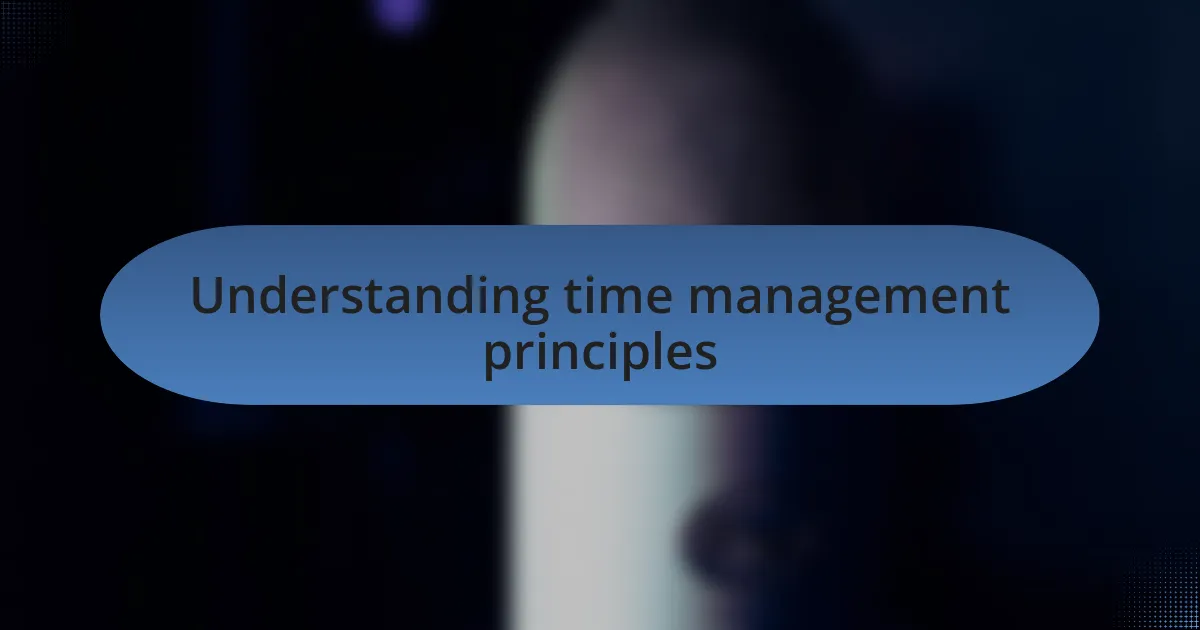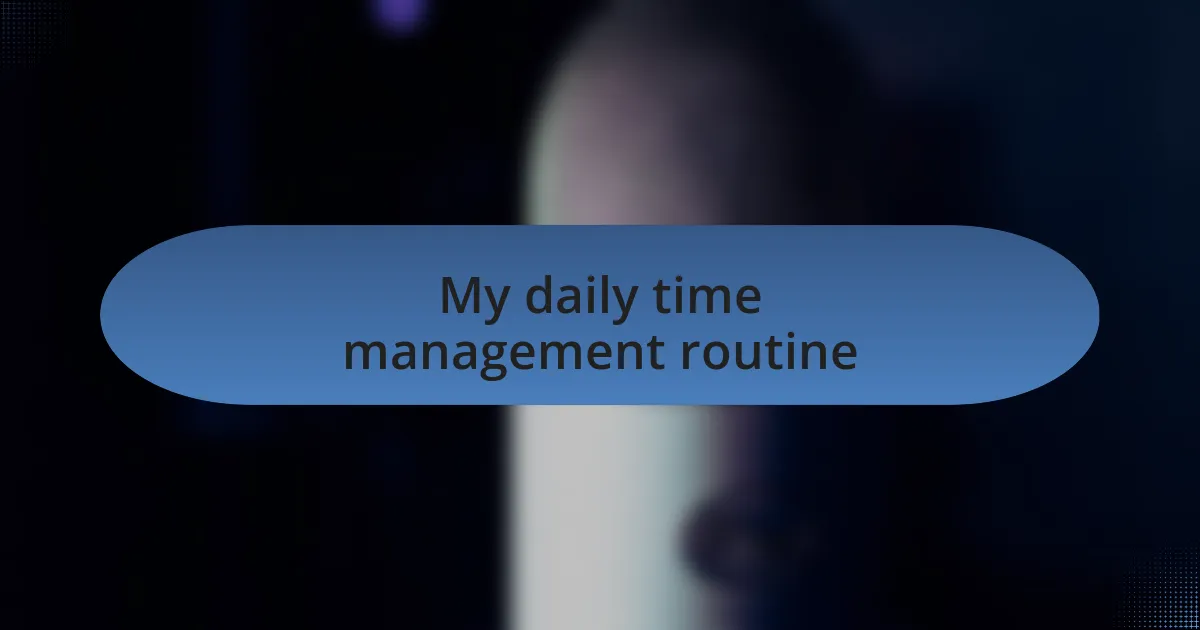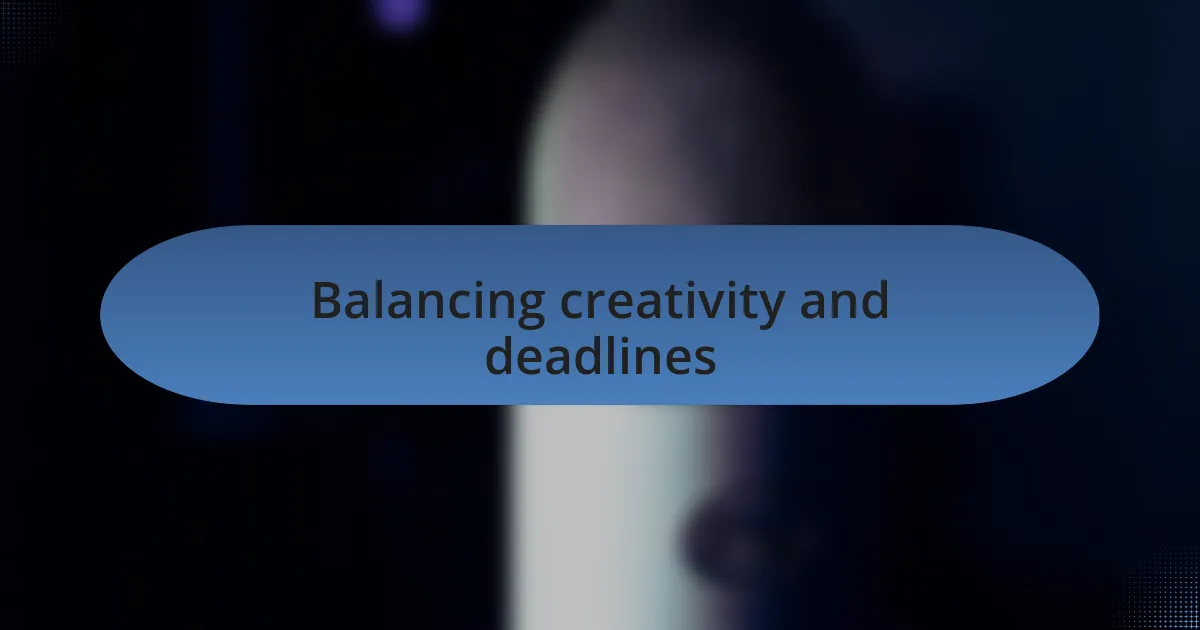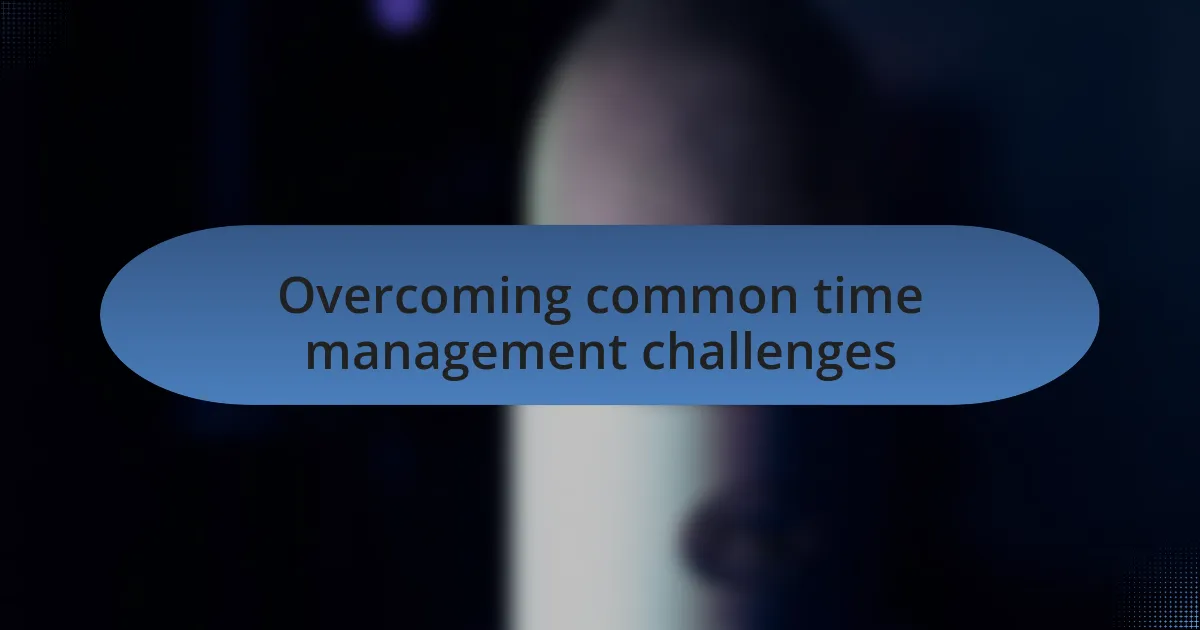Key takeaways:
- Effective time management involves prioritizing tasks using methods like the Eisenhower Matrix, which helps distinguish between urgent and important tasks.
- Techniques such as the Pomodoro Technique, setting self-imposed deadlines, and utilizing digital tools can enhance productivity and focus.
- Tracking production time with apps like Toggle or Clockify, or using spreadsheets, reveals work habits and helps identify areas for improvement.
- Establishing a routine with scheduled breaks and specific time slots for tasks fosters creativity while managing deadlines effectively.

Understanding time management principles
Effective time management is more than just scheduling; it’s about prioritizing tasks based on their importance and urgency. I’ve found that when I start my day with a clear, prioritized list, I not only feel more accomplished but also less overwhelmed. Have you ever left the studio feeling like you didn’t accomplish anything, even after a full day of work? That’s often a sign that tasks weren’t effectively prioritized.
One principle I lean on is the idea of the Eisenhower Matrix, which helps differentiate between what’s urgent and what’s important. By categorizing tasks this way, I allocate my energy more efficiently, preventing burnout. I remember a hectic week where I spent hours on tasks that, in hindsight, didn’t move my projects forward. That moment pushed me to reevaluate how I was spending my time.
Time blocking has also transformed the way I work. By dedicating specific chunks of time to different activities—like producing, brainstorming, or administrative tasks—I’ve minimized distractions significantly. This method reminds me to respect my creative flow, making each session feel more purposeful. Have you tried blocking out time for a specific task? It might surprise you how much you can accomplish when you focus solely on one thing at a time.

Techniques for effective time management
One technique that I swear by is the Pomodoro Technique. It’s simple yet effective; I work in focused 25-minute bursts followed by a 5-minute break. I remember initially being skeptical—how could short bursts possibly yield productivity? But after I tried it, I was amazed at how much I could accomplish in those concentrated intervals without feeling drained. Have you ever found that taking a short break actually recharges your creativity?
Another method is setting specific deadlines for myself, even when they aren’t required. For example, when I’m working on a new track, I give myself a deadline to complete the first draft. This self-imposed urgency forces me to stay committed and helps combat my tendency to overthink. The pressure can be intense, but there’s nothing like the rush of hitting that target and realizing I’ve made tangible progress. Have you tried creating your own deadlines to stay motivated?
Lastly, I often find myself using digital tools like Trello or Asana to track my tasks. These platforms allow me to visualize my workload, breaking it down into manageable steps. I used to feel overwhelmed by the sheer volume of what needed to be done, but seeing my tasks laid out clearly alleviates that stress. How often do you find yourself juggling multiple projects? I think organizing them visually makes a world of difference in staying focused and achieving my goals.
![]()
Tools for tracking production time
When it comes to tracking production time, I rely heavily on tools like Toggle or Clockify. These applications enable me to record how long I spend on each task, giving me a clearer picture of my work habits. I remember a time when I thought I was efficient, only to find out that I was wasting hours on minor tasks. Have you ever been surprised by how much time certain activities consume?
Additionally, I’ve experimented with spreadsheets for a more hands-on approach. I set up a simple document to log daily tasks, noting the start and end times. This method makes me feel more in control of my day. There’s something satisfying about seeing those timestamps add up. Have you considered how tracking your time might reveal where you can improve?
For a more creative twist, I’ve also used digital audio workstations (DAWs) equipped with time-tracking features. When I’m in the studio, knowing how long I spend on mixing and editing helps me balance my time across various aspects of production. It’s a game-changer when I see how my time aligns with my artistic vision. What tools do you think could bring clarity to your creative process?

My daily time management routine
My daily time management routine begins with a morning ritual that sets the tone for my entire day. I wake up early to plan my tasks, often over a cup of coffee. It’s a moment of peace that allows me to prioritize what truly matters. Have you ever noticed how starting your day with intention can change your productivity levels?
As I dive into my tasks, I allocate specific time slots for each activity. For instance, I dedicate the first few hours to creative work, like songwriting or producing beats, when my mind is freshest. I’ve found that this focused time really fuels my creativity. Do you have a particular time of day when you feel most inspired?
Throughout the day, I make it a point to take short breaks. I step away to clear my mind, which surprisingly helps me maintain my energy and focus. I remember a period when I would push through without breaks, thinking it was the best way to get things done, only to feel burnt out. Have you ever experienced that kind of fatigue? Taking those moments to recharge has made a significant difference in my productivity and overall well-being.

Balancing creativity and deadlines
Balancing creativity and deadlines can often feel like a tightrope walk. I recall a particularly intense session while collaborating on an album when we had both the enthusiasm of creativity and a looming deadline. There were moments when inspired ideas flowed freely, but I had to remind my team to stay focused; after all, we couldn’t let our artistic vision slip away while racing against the clock. How do you find that balance when you’re caught in a similar situation?
I often find that setting micro-deadlines within a bigger project helps manage this tension. For example, during the last track I produced, I broke down the creation process into manageable parts—like composing, mixing, and mastering—each with its own timeline. It allowed me to maintain a steady pace without stifling my creativity. Have you ever tried chunking your projects this way to see a clearer path forward?
To truly harness creativity under time constraints, I embrace flexibility. There was a time I rigidly adhered to my deadlines, thinking it would lead to efficiency. However, I learned that sometimes stepping back or even shifting my approach can yield better results. Have you ever had a moment of clarity that emerged from allowing yourself some breathing room? Trusting the process, even amid ticking clocks, often leads to breakthroughs that deadlines alone can’t deliver.

Overcoming common time management challenges
Navigating time management in a fast-paced environment can be tricky, especially when distractions are everywhere. I remember a phase when social media notifications would pull my attention away from important tasks. To combat this, I started setting specific hours where I’d disconnect entirely from my devices. Have you ever tried creating tech-free zones during your work hours? It can make a world of difference in maintaining focus.
Another challenge I faced was the tendency to overcommit. Early in my career, I was eager to say “yes” to every project, thinking it would open doors. I soon realized that spreading myself too thin diluted the quality of my work. Learning to say “no” without guilt was a game changer for me. How do you decide which opportunities align with your current goals?
Routine is powerful when it comes to managing time. I established a daily schedule that includes dedicated blocks for both creative work and administrative tasks. This structure allows me to transition smoothly between different types of productivity. Have you noticed how having a consistent routine can help you stay on track? It’s about finding what works best for you and sticking to it, while still allowing room for spontaneity when inspiration strikes.